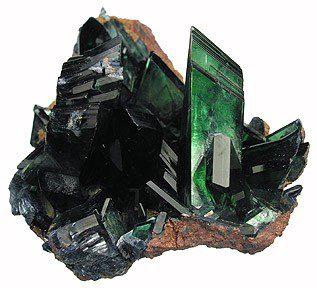Fans of the fantasy genre are probably used to the idea of special stones or crystals that have formed on ancient dead bodies and boast some sort of mystical property, but did you know there are real necro crystals in the world?
What is vivianite?
Vivianite, a rare phosphate mineral (Fe3(PO4)2−(H2O)8) has been found growing on organic materials such as fossil shells, animal waste deposits, and even on decomposing bodies.
The crystal, which is well known for its beautiful and vividly colored structures, develops in iron-rich sedimentary deposits containing bones, decayed wood, and other organic remains, especially in clay and sandstone. They can also be found in hydrothermal replacement deposits and in phosphate-rich granite pegmatites – igneous rock with a coarse texture and interlocking crystals.
The crystal is extremely fragile and, when freshly formed, is often pale white or transparent, but its color actually changes when it is exposed to light. This is caused by oxidation, which continues to darken the crystal through shades of blue, to darker green and purple, and eventually a thick purplish black.
Why does vivianite form on dead bodies?
Well, the key here is the interaction between iron, water, and phosphate. Our bodies contain plenty of phosphate, especially in our teeth and bones, which is released into the surrounding environment when we start to decompose. In rare conditions, where the surrounding area contains water and iron, the phosphate can react and form mineral vivianite.
In most cases, vivianite has been observed on bodies that have been buried for several centuries where it has formed on the bones and teeth. There are also far older examples where it has been found on the tusks of mammoths and the bones of other animals that are several thousands of years old, but there are a few instances where it has been identified on more recent human bodies.

In the 1960s, archaeologists discovered several bodies in Lake Walchen, Germany, which were partially skeletonized and also covered in fat wax, or Adipocere – a product of decomposition that turns body fat into a soap-like substance. One of the bodies had an iron plate fastened to it that had formed vivianite between it and the fat wax. An analysis of the body’s clothes indicated that it had probably been in the water for somewhere between 30 and 50 years and that the crystals could have only formed in such a short time because the iron plate had released sufficient iron II ions as it corroded, allowing the vivianite to grow on the phosphate-rich parts of the body.
In 1998, another team of researchers discovered vivianite on the remains of a US Serviceman who had been listed as missing in action from Vietnam since 1963 after his B-26B aircraft went missing. By analyzing the mineral, the researchers were able to conclude that the body had likely been buried in wet soil alongside parts of the plane, which allowed the vivianite to grow.
Vivianite has also been found on the body – inside and outside the skin and in the lung tissue – of “Ötzi”, the 5,300-year-old iceman discovered by a German tourist in the Tirolean Ötztal Alps in 1991. It is believed that the crystal formed on the body at the points where it had contact with iron-containing rocks.
Similarly, in 1996 another vivianite-encrusted adipocere body was discovered in a bay of Lake Brienz in Switzerland and is thought to belong to a man who drowned there sometime in the 1700s.
Vivianite was named in 1817 after John Henry Vivian, an English mineralogist who first discovered the mineral in Cornwall, England.
Source Link: Vivianite: The Necro Crystal You Never Knew Existed